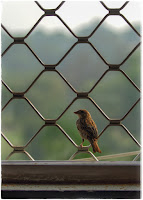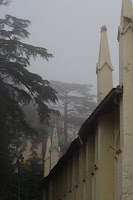Jerdon’s
Courser, Admiral… Jerdon’s Courser, it is! The name of the bird you were trying
to recall. That was my last message to him which he did not see.
I was at INHS Asvini visiting Vice Admiral Manohar Awati (retd) VrC PVSM who was admitted there for a cardio check-up. I had the
good fortune, unfortunately, of meeting him whenever he came down to the naval
hospital in my neighbourhood. I had just returned from a holiday in
Coonoor-Wellington-Ooty and had come to meet him as promised. He had desired
that I return with news of Nilgiris, a destination steeped in nostalgia for him.
“I used to go on field trips in the
hills with the Old Man,” he told me. ‘Old Man’ was the great ornithologist Dr. Salim
Ali with whom he went on numerous nature jaunts and explored India’s flora and fauna.
Our association went back several years, to the days when I was a Journalist in Mumbai covering defence and environment beat; I used to bump into him at events such as commissioning of naval ships or the Golden Jubilee of National Defence Academy. Though we did not meet often, we corresponded via emails, oftener. Ours was a relationship based on our mutual love and respect for nature and wildlife.
Our association went back several years, to the days when I was a Journalist in Mumbai covering defence and environment beat; I used to bump into him at events such as commissioning of naval ships or the Golden Jubilee of National Defence Academy. Though we did not meet often, we corresponded via emails, oftener. Ours was a relationship based on our mutual love and respect for nature and wildlife.
Not many may know that the
veteran naval officer was an avowed naturalist and conservationist. He was an honorary
member of Bombay Natural History Society (BNHS) who campaigned for the cause of nature conservation at the drop
of a hat. He even penned few books such as, “The Vanishing Indian Tiger” and “Homo Sapien and Panthera Leo”, the latter on the Gir lion. After
retirement, he had settled in the back of beyond Vinchurni, “nice countryside
blooming with ripening jowar and maize”, a perfect habitat for him. One
November (2013), he wrote in response to my blog on birding: “A pair of Great
Indian Horned Owl came my way as I almost walked past them in the shadow of a
spreading Pimpran (Ficus reticula) late one evening here in
Vinchurni. I was snapped out of my reverie as their eyes followed my movement,
past them. I thought the horns quivered a bit testifying to they being two
large erect feathers atop their heads imitating horns (hence the name). Now
that our tank is full after a lively Monsoon, there are a huge number and
varieties of water birds upon it. The last time in a similar situation seven
years back there was a small flock of flamingos here. They were obviously
reconnoitring. I did not see them again. This year there will be a goodly
number of ducks from the north come to winter on my tank. I look forward to a
busy cool season.”
On another occasion, in the peak
of summer, he wrote: “I am back in good old, drought-stricken Vinchurni where
there is a brown, dusty desert with nary a sign of even a blade of green. It is
very upsetting, but who can fight Mother Nature, certainly not those who have
despoiled her so heartily.” Even in his 80s, the Admiral was on the move
attending conferences, talks and events where he was invited to speak. On
return to Vinchurni he would catch up with communication unfailingly.
I would keep him posted of my
sojourns in Kenya/Africa through my blogs and he would respond promptly. He
told me once that he was offered the post of Wildlife Warden of Serengeti in
Tanzania which he had to, obviously, decline. I could well imagine this tall personage
with flowing white beard at home in a safari jeep as in a sailboat! On my verse
on Olduvai Gorge, the cradle of civilisation in the heart of Serengeti, he
commented: “Evocative, endearing and effervescent!”. He said that it was the nicest
poem he had read on Africa. “Keep writing. You may yet write a new chapter in
the relations between India and Africa, the oldest continuous civilisation on
earth and the progenitor place of Homo
Sapien Sapien,” he prodded me on in his inimitable way. When I shared my ‘Mombasa Msafari’ (Safari in Swahili) with him that was published in National Geographic
Traveller, he took me back to Mombasa of 1950’s that he visited.
“I first went there in June 1950
in the (destroyer) old RANJIT (emphasis his). The new Indian Navy having just
dropped her Royal patronage, was showing the new flag around the Ocean! The
Mombasa Club would not have us. So, our very British Rear Admiral Geoffrey
Barnard, RACINS, as he was identified and addressed in naval parlance and
signals, quarantined it. They relented and let the brown Englishmen in (!) in
an imposed, post-colonial egalitarianism. The wardroom returned the compliment.
The old harbour then known as the Dhow Port was crammed with Indian and Arab
Dhows much as the northern Bunders of Bombay used to be, the Lakdi, Koyala, Hay and numerous other Bunders of old Bombay Harbour. I
witnessed a busy scene in Mombasa Dhow Port, shiny black, sweating muscular
bodies clambering up the main sail yards to make or furl those massive cotton
sails. It must have been hard work entrusted only to the most able-bodied. I
last visited Mombasa in TIR, in command in 1965. It had not changed much in the
interim fifteen years.”
Back in India, at the Naval War College in INS Mandovi, I
wrote to him about the riches of the naval base, an ecological niche that
was million years old. In that April of 2013, he urged me
to explore Goa further. “By now you would have done the
Mandovi-Kumbharjua-Zuari cruise and would therefore be aware of the beautiful
marshes around Kumbharjua and their inhabitants, both avian and reptilian. If
you have not done that trip please do it now during the dry season because once
the rains set in the whole region is flooded, the birds have flown and the
reptiles washed away, probably. Nature, as always, will recover fast. The point
is will we? We must, to prove an important point that we belong to this earth.”
Love and concern for nature poured through his writings thus; his sense of seasons
and places was spot-on.
When I was stationed in
Visakhapatnam, the Admiral, who was visiting for the International Fleet Review, had set out to meet me at
my residence, unbeknown to me. Unfortunately, he couldn’t reach me as he had my
old phone number. I was deeply touched and honoured to know that he had come
all the way up the Dolphin Hill hoping that he could track me! By now, our
interactions were getting stronger and I could see I had a well-wisher in him. So
when I wrote about Dolphin Hill – about the Cyclone that hammered us into
submission and nature’s regeneration, a year later, in “Daydreaming and the Art of Living”, I was delighted by his spontaneity.
“What does Paddy do, what has
she been up to? She does a lot and has been up to a good deal during a day on
Dolphin's Nose. The devastation wrought by Cyclone Hoodoo or whatever it was
tabbed, has passed and the earth and Nature are restoring themselves, as they
always do, bringing happiness, even gaiety to her humans wherever we are. Paddy
has that rare quality and power to observe this gentle restoration through her
fellow beings all about her. A rare advantage, used so beautifully to acquaint
us ordinaries with Nature's pervasive beauty, kind and gentle ways. Paddy is
Her messenger to us, unnatural Hedons. Sit up and take note of Paddy's doings
if you wish to be Natural, get a little out of this, otherwise, meaningless
existence”! He made everyone feel special endearing him to all who were awed by him.
He did not stop at encouraging
words, but urged me to send my articles/blogs for publishing. The one on Dolphin
Hill’s Purple fountain grass had him raving. By now I was knee-deep into
photography, apart from writing, and ‘50 shades of Red’ was a perfect marriage
of both. “A poetic essay about seemingly insignificant weed. You have given it
a romantic palaver (is that an apposite word?). Should go to BNHS for Hornbill
for the amusement and appreciation of a wider readership. You will miss this in
Bombay, in the concrete jungle of NOFRA. Borivali National Park is not far; maybe
it awaits your magical camera,” he wrote when I was all set to come to Mumbai
on transfer.
It was here in Mumbai that I got
to meet him face-to-face again, on his medical sojourns to the naval hospital.
The last time I saw him before he moved on, like I mentioned earlier, was on my
return from the Coonoor-Ooty-Wellington. I had taken my camera to show him birds of Nilgiris on
the LCD as I narrated my experiences. That is when he was trying to recall the
nearly threatened bird endemic to Nilgiris. Awati had a photographic memory
that stowed away all manner of information in neatly stacked compartments to be
recalled at will, irrepressible raconteur that he was. This was just one of
those stray occasions when he couldn’t summon the name of the bird that he and
the legendary Salim Ali had tracked in the Blue Hills. Jerdon’s Courser was the
bird he was trying to recollect, I realised later.
Soon he was discharged and I
shared the edited pictures via email. On 10 October, he wrote back to say: “You
really are a wonder, a gift of Nature to the Navy. The latter has yet to
appreciate that. It will, one day”!
NOTE 1: Since I had the camera handy, I shot this portrait as he was being discharged from the hospital on 1st October. This may, possibly, be his last portrait.







































































